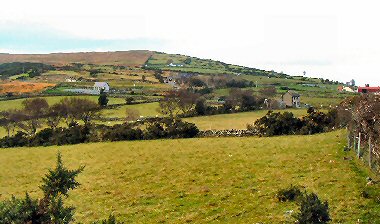There were many local names still familiar today in the lists compiled by Father Ryan of the householders in the townlands in his parish during the Great Hunger.
|
1 |
Daniel Magenis |
|
2 |
Daniel O’Hare |
|
3 |
Mrs James Kerr |
|
4 |
Thomas Cunningham |
|
5 |
John Trainor |
|
6 |
Mrs Cath O’Hare |
|
7 |
Patrick Morgan & Sister |
|
8 |
John O’Hare (Munday) |
|
9 |
John Rafferty |
|
10 |
John Dooley |
|
11 |
Elizabeth Bell |
|
12 |
Matthew Farrell |
|
13 |
Patrick Trainor |
|
14 |
Owen Connell |
|
15 |
Mrs Frank O’Hare |
|
16 |
Patrick Bell |
|
17 |
James Bell |
|
18 |
Daniel Bell |
|
19 |
Michael Kinley |
|
20 |
Arthur O’Hare |
|
21 |
Phillip Rafferty |
|
22 |
Daniel O’Hare (Art) |
|
23 |
Peter Rafferty, cottier |
|
24 |
Daniel O’Hare (Brian) |
Note the inclusion of nicknames, necessary where many in a parish shared the same surname and forename (count the number of Daniel O’Hares above).
Cottiers were the lowliest of land peasants – the special target of the authorities in the ‘clearances’ of ‘encumbered estates’. Normally a tenant sub-let to him a tiny portion (not more than a half acre) and he and his family lived in a lean-to or out-building.
The following, in explanation of the name Carrickovaddy, was contributed by Gordon Sim, by email: we are most grateful!
“In Scots gaelic, ‘ruadh a’mhadaidh’ invariably means fox, therefore ‘the foxes’ rock’ may be an alternative translation.
‘A’mhadaidh’ alone is almost always wolf and although scholars are inclined to suggest ‘mactire’ and ‘faol chu’ as Irish names for wolf. ‘A’mhadaidh’ seems to have been the common term amongst the local population with ‘chu’ and ‘con’ as better descriptions for dogs/hounds.
Wolves were plentiful in Down of the 16th/17th century, and foxes still are!”
